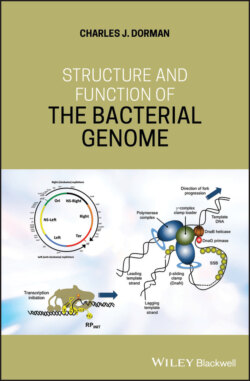Читать книгу Structure and Function of the Bacterial Genome - Charles J. Dorman - Страница 47
1.36 HU, a NAP with General DNA‐binding Activity
ОглавлениеThe HU protein from E. coli is the founder member of a superfamily of related NAPs found throughout the prokaryotic world and beyond (Burroughs et al. 2017). HU interacts with DNA in the minor groove and this encourages the bound DNA to follow a looped path (Figure 1.18). This property helps HU to overcome the resistance of the DNA to loop formation by overcoming DNA's intrinsic stiffness (Johnson et al. 1986). HU‐assisted loop formation contributes to the formation of nucleoprotein complexes involved in the control of transcription and site‐specific recombination (Haykinson and Johnson 1993; Semsey et al. 2004). It also has RNA‐binding activity, enabling it to influence translation (Balandina et al. 2001).
Each HU subunit inserts a beta sheet with an apical proline amino acid into the minor groove of the DNA at the binding site, inducing the DNA to bend (Figure 1.18). The bend angle is typically in the range of 105°–140° and bends are not coplanar, having a dihedral angle that is consistent with the path taken in negatively supercoiled DNA (Swinger et al. 2003). The flexibility in the bend angle, coupled with the absence of a strict nucleotide sequence for DNA binding, may allow HU to participate as an architectural component in a wide variety of DNA‐based transactions.
The α and β subunits of HU are encoded, respectively, by the hupA and hupB genes, located at distinct positions on the chromosome: hupA hupB double mutants that fail to express the HU protein display a filamentous cell phenotype because of disruption of the cell cycle due to the arrest of DNA replication (Dri et al. 1991). HU interacts with the DnaA protein at oriC where it stimulates formation of the initiation complex in chromosome replication. Like IHF, HU is usually heterodimeric and is composed of an alpha and a beta subunit. The alpha subunit seems to have the primary responsibility for interacting with DnaA. This preference for the alpha subunit may facilitate enhanced HU–DnaA interaction at early stages of growth when an HU α2 homodimer predominates rather than the αβ heterodimer (Chodavarapu et al. 2008). HU can also influence chromosome replication initiation indirectly by repressing the expression of the gene that encodes SeqA (Lee, H., et al. 2001), the protein that sequesters oriC and excludes DnaA (Han et al. 2003; Slater et al. 1995; von Freiesleben et al. 1994).
The HU protein can form nucleosome‐like structures in E. coli that are dependent on the local HU‐to‐DNA ratio (Sagi et al. 2004). It has been described as insulating transcription units on the chromosome by preventing changes in DNA supercoiling caused by transcription in one unit from influencing an adjacent one (Berger et al. 2016). HU may be particularly important for the maintenance of DNA supercoiling levels in the Ter macrodomain as the bacterium enters the stationary phase of the growth cycle (Lal et al. 2016). It has been reported to induce, together with FIS, weak and transient domain boundaries around the E. coli chromosome (Wu et al. 2019).
In laboratory‐grown cultures, the subunit composition of the HU protein changes as a function of growth phase: In lag phase, as the bacterium adapts to its new environment, the α2 form of HU occurs; in exponential growth the αβ form predominates and the β2 form is detected as the culture enters stationary phase (Claret and Rouvière ‐Yaniv 1997). The changing subunit composition of HU and the different DNA interaction properties of the distinct HU forms may contribute to processes that differentially compact the chromosome in the nucleoid and affect gene expression patterns (Hammel et al. 2016). Transcriptomic studies in Salmonella have shown that each form of the HU protein seems to govern a distinct group of genes, with overlaps between the three sub‐regulons (Mangan et al. 2011).
